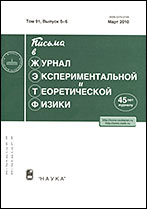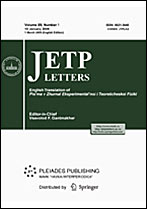|
This article is cited in 1 scientific paper (total in 1 paper)
OPTICS AND NUCLEAR PHYSICS
Anisotropy of a terahertz electromagnetic response of filament microstructures of a composite based on polypropylene with carbon nanofibers
A. V. Andrianova, A. N. Aleshina, P. A. Aleshina, O. A. Moskalyuka, V. E. Yudinb
a Ioffe Institute, St. Petersburg, 194021 Russia
b Institute of Macromolecular Compounds, Russian Academy of Sciences, St. Petersburg, 199004 Russia
Abstract:
Linear dichroism and birefringence are detected in composite microfilaments consisting of polypropylene with carbon nanofibers in the terahertz spectral range. The magnitude of linear dichroism is a nonmonotonic function of the frequency, reaches values about 60% at low frequencies of 0.2–0.8 THz, then changes sign, and reaches -50% at a frequency of 1.8 THz, at which the maximum of the absorption band is observed in the microstructures under study. Birefrengence (the difference between the effective refractive indices of the ordinary and extraordinary waves) also changes sign at a frequency of about 1.5 THz, which is apparently due to the manifestation of resonant absorption in the studied microstructures near 1.8 THz. The observed birefringence is due to carbon nanofibers that are incorporated into the polypropylene filaments and are aligned in a certain manner because of the high-temperature stretching of filaments.
Received: 13.10.2021
Revised: 17.11.2021
Accepted: 17.11.2021
Citation:
A. V. Andrianov, A. N. Aleshin, P. A. Aleshin, O. A. Moskalyuk, V. E. Yudin, “Anisotropy of a terahertz electromagnetic response of filament microstructures of a composite based on polypropylene with carbon nanofibers”, Pis'ma v Zh. Èksper. Teoret. Fiz., 115:1 (2022), 10–14; JETP Letters, 115:1 (2022), 7–10
Linking options:
https://www.mathnet.ru/eng/jetpl6578 https://www.mathnet.ru/eng/jetpl/v115/i1/p10
|


| Statistics & downloads: |
| Abstract page: | 130 | | Full-text PDF : | 7 | | References: | 25 | | First page: | 13 |
|





 Contact us:
Contact us: Terms of Use
Terms of Use
 Registration to the website
Registration to the website Logotypes
Logotypes









 Citation in format
Citation in format 